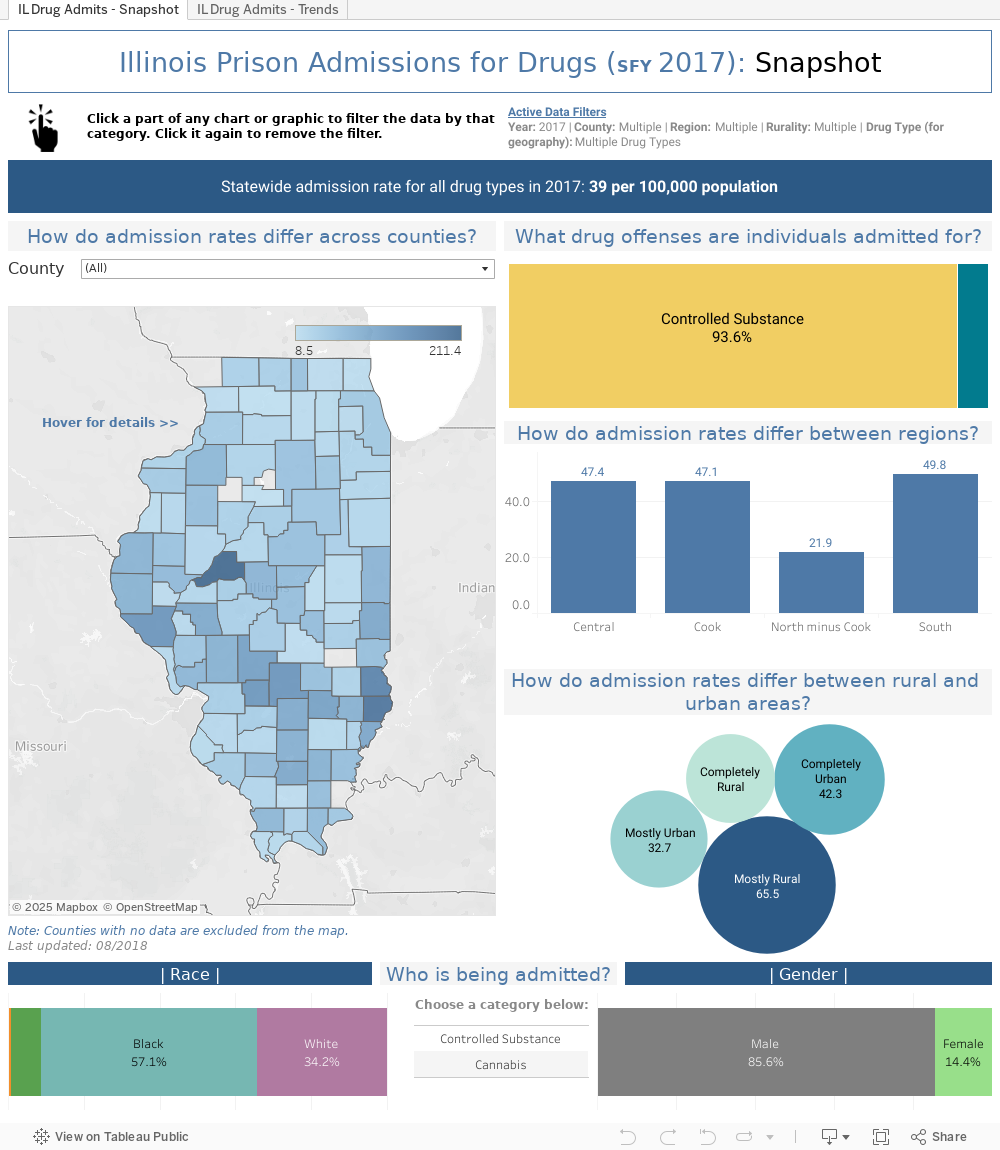Illinois Arrests and Prison Admissions for Drug Offenses: Interactive Data
Introduction
The criminal justice system’s response to drug activity varies over time and by type of substance. The availability of substances, changes in use patterns, shifting policies [1] and public opinion can all play a role.[2] Recently, states and local governments have enacted changes to the way drug activity related to cannabis or opioids is dealt with throughout the criminal justice system. These changes can be made to serve a variety of purposes, including reducing time and resources spent on enforcement activities, addressing problematic disparities in the system, and combating rising threats to health and safety.[3] The Arrests dashboard allows users to explore the types of drug offenses for which individuals are arrested and the locations in which different types of drug arrests occur in Illinois. The Prison Admissions dashboard allows users to explore data on prison admissions for drug offenses, including characteristics of those admitted for each type of drug offense.
Arrests for Drug Offenses
Data Sources
- The Illinois Uniform Crime Report (I-UCR) published by the Illinois State Police (ISP) was the source for drug arrest data. The counts represent the most recent totals published as of the last update to the dashboard.
- The U.S. Census Bureau was the source for rural or urban distinctions and population data used in rate calculations.
Data Notes
- ICJIA researchers will make periodic updates when annual I-UCR data is made available by the ISP (e.g. revised/corrected arrest numbers).
- Counties with no available data do not appear in the county selection list or on the Illinois map unless they explicitly reported no (zero) arrests.
- Changes in law, policy, and practice may contribute to arrest trends seen over time. Read the ICJIA article about UCR data to learn more regarding the data and how reporting has changed over the years in Illinois.
- Arrests for drug offenses specifically involving methamphetamine are not available in I-UCR data until 2010, when a legislative act (720 ILCS 646) was passed to recognize it as a unique drug-related criminal offense.
Prison Admissions for Drug Offenses
Data Sources
- The Illinois Department of Corrections (IDOC) was the source for drug admission data. The counts represent the most recent totals accessed as of the last update to the dashboard.
- The U.S. Census Bureau was the source for rural or urban distinctions and population data used in rate calculations.
Data Notes
- Admissions to IDOC for drug offenses include possession, manufacture, delivery, production, and/or traffic conspiracy.
- Illinois Department of Corrections data are reported by State Fiscal Year (SFY), which runs from July 1st to June 30th of the following year.
- Drug admission data by geography is based on IDOC information about the county where an individual was sentenced to a prison.
- ICJIA researchers may make periodic updates to the dashboard when IDOC data is updated.
- Counties with no reported prison admissions do not appear in the county selection list or on the Illinois map.
- Changes in law, policy, and practice may all contribute to admission trends over time.
Wisniewski, M. (2012, June 27). Chicago decriminalizes possession of small amounts of marijuana. Reuters.Retrieved from https://reut.rs/2Ck5wbK; Garcia, M. (2016, July 29). Rauner reduces punishment for minor pot possession from jail to citation. Chicago Tribune. Retrieved from https://trib.in/2yFpn1w ↩︎
Sacco, L. N. (2014). Drug enforcement in the united states: history, policy, and trends. Washington D.C.: Congressional Research Service. Retrieved from https://fas.org/sgp/crs/misc/R43749.pdf ↩︎
Reichert, J. (2017). Fighting the opioid crisis through substance use disorder treatment: a study of a police program model in Illinois. Chicago, IL: Illinois Criminal Justice Information Authority. ↩︎
Justin Escamilla is a Research Analyst in ICJIA's Center for Justice Research and Evaluation.
Sharyn Adams is a Research Analyst in ICJIA's Center for Justice Research and Evaluation.

